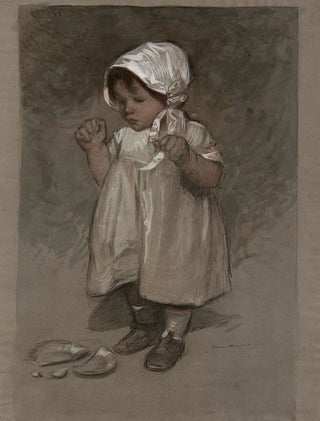Art print | Child study - Firmin Bouisset


View from behind

Frame (optional)
Firmin Bouisset's artwork "Child Study" is part of an artistic tradition that celebrates innocence and purity of childhood. Capturing a fleeting moment, this painting evokes a palpable tenderness, a shared gaze between the artist and their subject. Bouisset, through this piece, manages to transcend the simple portrait to offer a true immersion into the childhood universe. The soft light bathing the child's face creates a delicate, almost ethereal atmosphere, inviting the viewer to delve into memories of a bygone childhood. Through this art print, the artist succeeds in evoking universal emotions, reminding everyone of the beauty of simple and authentic moments.
Style and uniqueness of the work
The originality of "Child Study" lies in the mastery of chiaroscuro, a technique Bouisset uses brilliantly to bring his subject to life. The delicate shadows outlining the face give the piece an almost sculptural dimension. Every detail is carefully observed, from the fine features of the face to the glints of light in the eyes, reflecting a keen sensitivity to human nature. The choice of colors, subtly nuanced, helps create an intimate atmosphere, where the softness of pastel tones evokes childhood innocence. This work also stands out for its realistic approach, while maintaining a poetic lightness that characterizes Bouisset's style. The artist thus manages to capture not only the physical appearance of the child but also their essence, their soul, making the piece deeply touching.
The artist and their influence
Firmin Bouisset, a French painter of the 19th century, left a mark on his era with his exceptional talent and artistic sensitivity. Trained at the École des Beaux-Arts, he quickly developed a style blending realism and romanticism, influenced by the masters of classical painting. Bouisset is distinguished by his interest in themes of childhood and motherhood, which he approaches with infinite tenderness. His works, often imbued with nostalgia, bear witness to an era where childhood was perceived as a world

Matte finish

View from behind

Frame (optional)
Firmin Bouisset's artwork "Child Study" is part of an artistic tradition that celebrates innocence and purity of childhood. Capturing a fleeting moment, this painting evokes a palpable tenderness, a shared gaze between the artist and their subject. Bouisset, through this piece, manages to transcend the simple portrait to offer a true immersion into the childhood universe. The soft light bathing the child's face creates a delicate, almost ethereal atmosphere, inviting the viewer to delve into memories of a bygone childhood. Through this art print, the artist succeeds in evoking universal emotions, reminding everyone of the beauty of simple and authentic moments.
Style and uniqueness of the work
The originality of "Child Study" lies in the mastery of chiaroscuro, a technique Bouisset uses brilliantly to bring his subject to life. The delicate shadows outlining the face give the piece an almost sculptural dimension. Every detail is carefully observed, from the fine features of the face to the glints of light in the eyes, reflecting a keen sensitivity to human nature. The choice of colors, subtly nuanced, helps create an intimate atmosphere, where the softness of pastel tones evokes childhood innocence. This work also stands out for its realistic approach, while maintaining a poetic lightness that characterizes Bouisset's style. The artist thus manages to capture not only the physical appearance of the child but also their essence, their soul, making the piece deeply touching.
The artist and their influence
Firmin Bouisset, a French painter of the 19th century, left a mark on his era with his exceptional talent and artistic sensitivity. Trained at the École des Beaux-Arts, he quickly developed a style blending realism and romanticism, influenced by the masters of classical painting. Bouisset is distinguished by his interest in themes of childhood and motherhood, which he approaches with infinite tenderness. His works, often imbued with nostalgia, bear witness to an era where childhood was perceived as a world






